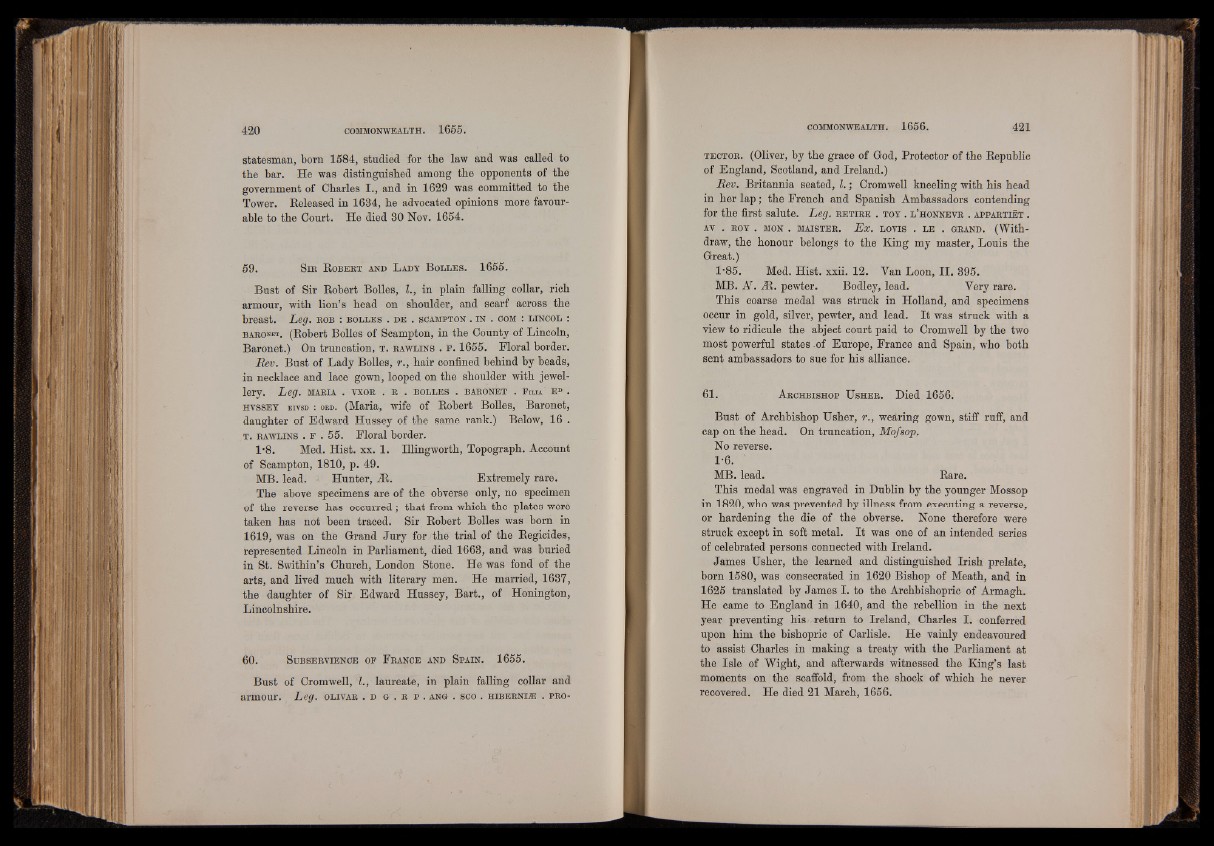
statesman, born 1584, studied for the law and was called to
the bar. He was distinguished among the opponents of the
government of Charles I., and in 1629 was committed to the
Tower. Released in 1634, he advocated opinions more favourable
to the Court. He died 30 Nov. 1654.
59. S i r R o b e r t and L ady B o l l e s . 1655.
Bust of Sir Robert Bolles, I., in plain falling collar, rich
armour, with lion’s head on shoulder, and scarf across the
breast. Leg. rob : b o l l e s . d e . scampton . in . com : l in c o l :
baromt. (Robert Bolles of Scampton, in the County of Lincoln,
Baronet.) On truncation, t . r aw l in s . f . 1655. Floral border.
Rev. Bust of Lady Bolles, r., hair confined behind by beads,
in necklace and lace gown, looped on the shoulder with jewellery.
Leg. MARIA . VXOR . R . BOLLES . BARONET . Filia Ed .
hvssey eivkd : obj). (Maria, wife of Robert Bolles, Baronet,
daughter of Edward Hussey of the same rank.) Below, 16 .
t . rawuns . f . 55. Floral border.
1*8. Med. Hist. xx. 1. Illingworth, Topograph. Account
of Scampton, 1810, p. 49.
MB. lead. Hunter, JR. Extremely rare.
The above specimens are of the obverse only, no specimen
of the reverse has occurred; that from which the plates were
taken has not been traced. Sir Robert Bolles was born in
1619, was on the Grand Jury for the trial of the Regicides,
represented Lincoln in Parliament, died 1663, and was buried
in St. Swithin’s Church, London Stone. He was fond of the
arts, and lived much with literary men. He married, 1637,
the daughter of Sir Edward Hussey, Bart., of Honington,
Lincolnshire.
60. S u b s e r v ie n c e o f F r a nc e and S pa in . 1655.
Bust of Cromwell, I., laureate, in plain falling collar and
armour. Leg. o l i v a r . d g . r p . a n g . sco . h ib e r n i .® . p r o t
e c t o r . (Oliver, by the grace of God, Protector of the Republic
of England, Scotland, and Ireland.)
Rev. Britannia seated, I. ; Cromwell kneeling with his head
in her lap ; the French and Spanish Ambassadors contending
for the first salute. Leg. r e t i r e . t o y . l ’h o n n e v r . a p p a r t i e t .
AY . ROY . MON . MAISTER. Ex. LOVIS . LE . GRAND. (Withdraw,
the honour belongs to the King my master, Louis the
Great.)
1*85. Med. Hist. xxii. 12. Yan Loon, II. 395.
MB. N . JR. pewter. Bodley, lead. Very rare.
This coarse medal was struck in Holland, and specimens
occur in gold, silver, pewter, and lead. I t was struck with a
view to ridicule the abject court paid to Cromwell by the two
most powerful states of Europe, France and Spain, who both
sent ambassadors to sue for his alliance.
61. Ar c h b is h o p U s h e r . Died 1656.
Bust of Archbishop Usher, r., wearing gown, stiff ruff, and
cap on the head. On truncation, Mofsop.
No reverse.
1-6.
MB. lead. Rare.
This medal was engraved in Dublin by the younger Mossop
in 1820, who was prevented by illness from executing a reverse,
or hardening the die of the obverse. None therefore were
struck except in soft metal. I t was one of an intended series
of celebrated persons connected with Ireland.
James Usher, the learned and distinguished Irish prelate,
born 1580, was consecrated in 1620 Bishop of Meath, and in
1625 translated by James I. to the Archbishopric of Armagh.
He came to England in 1640, and the rebellion in the next
year preventing his return to Ireland, Charles I. conferred
upon him the bishopric of Carlisle. He vainly endeavoured
to assist Charles in making a treaty with the Parliament at
the Isle of Wight, and afterwards witnessed the King’s last
moments on the scaffold, from the shock of which he never
recovered. He died 21 March, 1656.